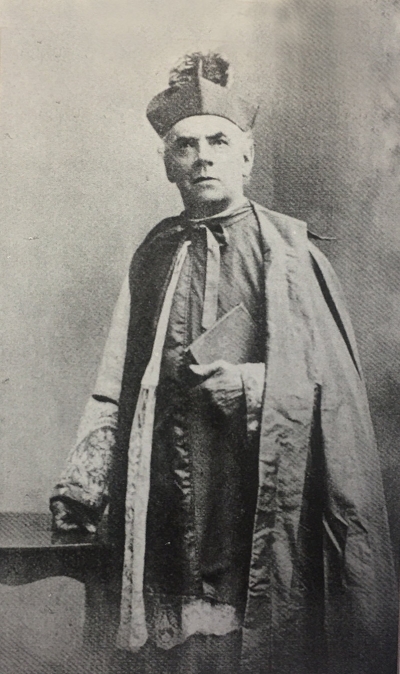
Born in the German duchy of Baden, but brought to the United States as an infant, Father Albert Lings is eminently worthy to be counted among those figures reckoned as pillars of Yonkers.
For Yonkers was an enormously different place on July 6, 1915, the day of his death, from what it was when he arrived here in September 1867, and many of the significant changes were due to intervening events in which Father Lings played a significant role.
Not long after arriving here as a young priest taking up his second assignment—to be the assistant pastor at St. Mary's, the Church of the Immaculate Conception, on South Broadway—Albert Lings was selected to establish a second Catholic parish in Yonkers, on what has long been known as ”'the Hill,"" a steep area north and east of Getty Square.
At the cost of $17,000, a lot on the northeast corner of Ashburton and Oak Hill Avenues was purchased in 1871 for the construction of the new parish's church, and the cornerstone was laid on Sunday, September 24. The new parish was named in honor of Saint Joseph. In the weeks before the church building was completed, Father Lings celebrated Sunday Mass in the auditorium of Public School 6, which he rented for $15 a week.
It was reportedly on All Saints Day, November 1, 1871, that Mass was first celebrated in the not-quite-finished church.
The current church building is the second church, called for by the growth of the parish a mere 15 years after its founding. The new church was dedicated by Archbishop Michael Corrigan on Sunday, January 29, 1888. Reporting on the dedication ceremonies in its issue of January 30, the New York Times took particular note of the church's 17 beautiful stained glass windows, all of them manufactured in Munich. 6,000 Catholics, the Times reported, lived within the boundaries of the parish.
Near the northwestern corner of Yonkers lies St. Joseph's Cemetery, another part of the legacy of Father Lings, who in an act of great prescience in 1877 purchased the property when it was farmland. The cemetery has continued to operate to the present day.
A parish school was established by Father Lings in September 1872. Despite some early fits and starts, it operated for about 100 years, until the changing demographics of the 1970s rendered it too costly to keep open. For many, many years, the school was staffed by the Sisters of Charity.
Monsignor Thomas J. Shelley, erstwhile professor of history at St. Joseph's Seminary and Fordham University, has written a good deal about Father Lings, both in his 2002 book Slovaks on the Hudson and in a 1996 article, Dean Lings's Church: The success of ethnic Catholicism in Yonkers in the 1890s. (After being made a monsignor, Father Lings was chosen to be the vicar, or dean, of Westchester, Putnam, and Dutchess counties, a position he held until his death.)
Shelley tells us in his article that the influx of immigrants to Yonkers in the last decade of the 19th Century, many of them Catholic, presented a great challenge to the Archdiocese of New York. Why? Because unlike earlier waves of immigrants, the newcomers were largely from Eastern and Southern Europe and they both needed and wanted priests of their own ethnicity to serve them in their adopted homeland. It fell to Father Lings to deal with the new groups in Yonkers and to provide Archbishop Corrigan with information about their situation and also with advice about how best to meet their spiritual needs. The number of Catholic parishes here, Shelley relates, grew from two to nine during the course of the 1890s, and five of the new parishes were so-called national parishes where each major group among the new immigrants was provided with priests of its own ethnicity to preach and minister to it in its own native language.
This concession—to initiate these national parishes in contradistinction to the usual model of the territorial parish —was largely due to the efforts of Father Lings on behalf of the new immigrants. The resulting parishes of St. Casimir's, St. Michael's, and Our Lady of Mount Carmel continue to serve Catholics in Yonkers to this day.
(Note that Monsignor Shelley's article can be accessed on JSTOR and that his book is owned by the Yonkers Public Library.)
In 1939, the homes of many parishioners of St. Joseph's were doomed when it was decided that Mulford Gardens, Yonkers' first federal housing project, was to be constructed on the land where those homes stood. The local newspaper of the day, the Yonkers Herald Statesman, published a series of articles at the time, written by Erwin Savelson, as a sort of commemorative history of the area known as The Hill. Included in that series was an article on Father Lings.
Noteworthy among the events chronicled by Mr. Savelson is his brief account of Father Lings's response to the financial panic of 1893. ""When the bottom dropped out of the 1893 markets,"" he wrote, ""[Father Lings] acted quickly. He stocked his church basement with flour, potatoes, bread, vegetables and fruit. Then he sent forth word that all who were hungry need only to come to him. They came—men and women of all faiths—and Father Lings smiled benevolently as he gave to the poor without distinction for race or creed.""
Having touched the lives of thousands, as priest and public benefactor, Monsignor Albert A. Lings died in his rectory on July 6, 1915, at the age of 71.
In its brief obituary notice, the New York Times noted that Monsignor Lings was known as both an author and a translator. His 1899 book, Our Monthly Devotions, has been posted on the Project Gutenberg website, where it may be read or downloaded free of charge.
Monsignor Albert A. Lings is buried in St. Joseph's Cemetery.
"